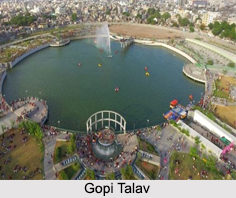 Gopi Talav is a lake in the Gopipura locality in the city of Surat in Gujarat. Gopi Talav is well maintained by the Municipality of Surat. In 2012, Gopi Talav and the surrounding areas were renovated. The Government of Gujarat and the Surat Municipality undertook it as an eco tourism spot. Many species of fishes and birds are found here thus contributing to a great atmosphere for photography.
Gopi Talav is a lake in the Gopipura locality in the city of Surat in Gujarat. Gopi Talav is well maintained by the Municipality of Surat. In 2012, Gopi Talav and the surrounding areas were renovated. The Government of Gujarat and the Surat Municipality undertook it as an eco tourism spot. Many species of fishes and birds are found here thus contributing to a great atmosphere for photography.
History of Gopi Talav
Gopi Talav was built in 1510 CE by Malik Gopi, who was an affluent merchant and Governor of Surat during the rule of Mughal Dynasty. Malik Gopi, a Brahmin merchant, settled in Surat and the development of the city has been attributed to his contributions. The area, developed by Malik Gopi was called Gopipura, in his honour and the king of Gujarat gave him the title of "Malik"
Gopi Talav in Indian Literature and History
A noted Sanskrit poet Vinayavijaya (1613-1681) in his poem "Indudutam" calls this lake a "fine art emerged from the churning of oceans". The lake also finds mentions in travelogues of European visitors. British traveller Peter Mundy who arrived in Surat in September 1628 describes the lake as "the Great Tancke of Surat". Dutch geographer Joannes de Laet`s in 1631 mentioned this lake to have been cut out of a rock.
Geography of Modern Gopi Talav
The modern Gopi Talav is stretching around 90,000 square metres (970,000 sq ft) of land was renovated, where the 212 metres (696 ft) diameter lake covered almost 35,000 square metres (380,000 sq ft) of area. The lake can hold 120,000,000 litres of water.
Amenities of Gopi Talav
The redevelopment of Gopi Talav and the park around it is based on the renovation of Kankaria Lake in Ahmedabad. The renovated surroundings include amphitheatre and fountain plaza. The area has been divided into 7 zones:
1. Diamond Zone
2. Food Zone
3. Environment Zone
4. History Zone
5. Communal Harmony Zone
6. Textile Zone
7. Surat Nu Jaman
The Surat Municipal Corporation has outsourced the operation and maintenance of these to a local company called "Rajhans Entertainment" which would develop an amusement park called "Future Zone". Water to the lake was piped from the Tapi River on whose banks the city lies and acts as a major life line of this area.















